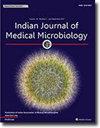Association of ALS genes in strains of the genus Candida with cervical cytological alterations
IF 1.4
4区 医学
Q4 IMMUNOLOGY
引用次数: 0
Abstract
Purpose
Fungi are an important cause of human infection and include infections caused by Candida species. Vaginal candidiasis is a mycosis caused by several species of the genus Candida. In Mexico, it is considered the only mycosis that must be reported to health authorities. The participation and/or contribution of Candida ALS genes to the presence of cervical cytological alterations is currently unknown. The purpose of this study was to elucidate the frequency of Candida ALS genes and their association with clinical characteristics.
Methods
The number of randomly selected samples was 697, of which 53 were Candida positive. Samples were selected from women attending gynaecological outpatient clinics for cervical cancer screening at Hospital Juarez de Mexico. These strains were identified, and genomic DNA was obtained from each isolate. Molecular assays were performed by endpoint PCR amplification of ALS genes.
Results
The predominant Candida species identified in the study were Candida tropicalis and Candida albicans. ALS1 12 (22.6 %) and ALS3 19 (35.8 %) genes were found. ALS2, ALS4, ALS5, ALS6, ALS7, and ALS9 genes were not detected. ALS1 was the gene that was associated with patients using corticosteroids.
Conclusions
Vulvovaginitis remains one of the most prevalent conditions in patients in their 20s and 30s, and it is a real public health problem. Further studies are needed to determine the direct involvement of the identified ALS genes in the pathogen's ability to adhere and how it causes transient change in vaginal cytology.
念珠菌属ALS基因与宫颈细胞学改变的关系
目的真菌是人类感染的重要原因,包括念珠菌引起的感染。阴道念珠菌病是由念珠菌属的几个物种引起的真菌病。在墨西哥,它被认为是唯一一种必须向卫生当局报告的真菌病。念珠菌ALS基因对宫颈细胞学改变的参与和/或贡献目前尚不清楚。本研究的目的是阐明念珠菌ALS基因的频率及其与临床特征的关系。方法随机抽取样本697份,其中念珠菌阳性53份。样本取自在墨西哥华雷斯医院妇科门诊接受子宫颈癌筛查的妇女。对这些菌株进行鉴定,并从每个分离株中获得基因组DNA。用终点PCR扩增ALS基因进行分子检测。结果本研究鉴定的主要念珠菌种为热带念珠菌和白色念珠菌。ALS1 12(22.6%)和ALS3 19(35.8%)基因。未检出ALS2、ALS4、ALS5、ALS6、ALS7、ALS9基因。als基因与使用皮质类固醇的患者有关。结论外阴阴道炎是20 - 30岁人群中最常见的疾病之一,是一个严重的公共卫生问题。需要进一步的研究来确定已鉴定的ALS基因在病原体粘附能力中的直接参与以及它如何引起阴道细胞学的短暂变化。
本文章由计算机程序翻译,如有差异,请以英文原文为准。
求助全文
约1分钟内获得全文
求助全文
来源期刊

Indian Journal of Medical Microbiology
IMMUNOLOGY-
CiteScore
2.20
自引率
0.00%
发文量
154
审稿时长
73 days
期刊介绍:
Manuscripts of high standard in the form of original research, multicentric studies, meta analysis, are accepted. Current reports can be submitted as brief communications. Case reports must include review of current literature, clinical details, outcome and follow up. Letters to the editor must be a comment on or pertain to a manuscript already published in the IJMM or in relation to preliminary communication of a larger study.
Review articles, Special Articles or Guest Editorials are accepted on invitation.
 求助内容:
求助内容: 应助结果提醒方式:
应助结果提醒方式:


